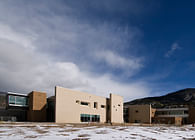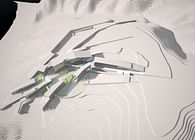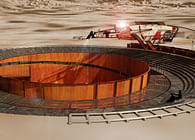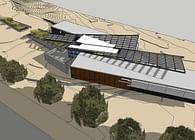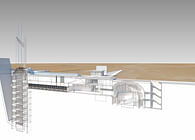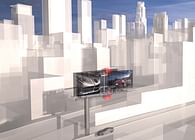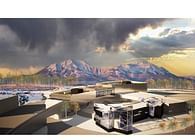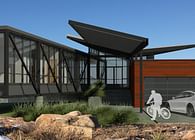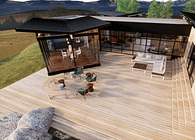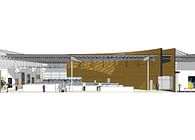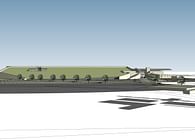
Colorado Springs, CO, US
COLORADO SPRINGS SD20 - INSCRIPTIONS K-8 ECO SCHOOL
Black Forest Preserve, Colorado Springs, USA (in progress - pending real estate acquisition)
Design Principles: The School is inscribed into the site relative to it’s program and setting, and is organized into three zones according to curriculum and curriculum delivery method:
LandForm Mass = support services (A)
BioForm Mass = Arts+Sciences+Media (B)
Bridge Structures = core learning studios (C)
The initial organization intuitively follows the topography, eventually winding down the gentle topography. This organization creates a pathway that encircles a large outdoor teaching space, acting as the heart of the campus.
Construction: The LandForm and BioForm Masses are constructed of integrally-insulated pre-cast concrete and SIP panel/TPO roofing systems, often used as retaining walls. Retaining wall buttresses are enlarged to hold mechanical rooms.
The Bridge Structures are pre-constructed, moment-joint steel ‘pedestrian bridge’ shipped to the site and installed in-situ. These include a 4’ mechanical chase below floor level, which holds all systems. Roofs are of SIP panels with TPO membranes. Aluminum glazing systems are ‘in-board’ installed, inside the structural frame. Steel sun shades and rain-screen phenalic panels shade all glazing.
A steel canopy provides support for 235kW PV system, fed back to the grid. Ironically, the canopy’s greatest energy-saving characteristic is in shading the classroom structures.
Sustainable Tangibles:
Lower initial construction cost: primarily from employing ‘component design’ techniques - the use of pre-manufactured, high-tech, highly-coordinated components that focus on ‘assembly’ on site rather than on ‘construction’. based upon current test models, saves 12%-18% of overall construction cost through various means, ‘component design’ being the primary driver.
Lower long-term maintenance cost: steel, aluminum, glass, concrete, phenalic panels, insulated metal panels.
Lower energy consumption: a combinatory product of the following:
Lower Construction Waste: by pre-manufacturing of a majority of the major building components and detailing to accommodate rapid placement, job-site waste is anticipated to reduce by 41%.
Lower Construction Time: anticipated reduction of construction time from 12 months to 9.5 months.
Less Footprint/Less Land Needed/Less Land Disturbance: compact design coupled with less foundation results in less footprint, less land required, and less disturbance (and less construction cost).
Flexible Floor Plates - interior changes: because of Narrow Floor-Plate construction (specifically provided by the ‘Bridge’ classroom wings), there is a lack of load-bearing interior walls. this increases flexibility.
Flexible Floor Plans- mechanical: ‘Bridge’ classroom structures have a 4’ mechanical space below the floor for all mechanical and technologies. All are readily accessible without disturbing instruction.
Better Emergency Event Strategy: rather than relying on systems, the architecture itself provides the mechanism for proper event-strategy planning through:
Sustainable Intangibles: There is a constant emphasis on Emerson’s thought, that ‘to know nature is to know oneself”. The natural world, not the man-made, is predominant.
Status: Unbuilt
Location: Colorado Springs, Colorado, USA
My Role: Principal, Lead Design Architect, Project Architect
Additional Credits: Brian Elyo, Sam Friesema, Ryan Ekstrom, Kenny LaGreca (structural engineer)


